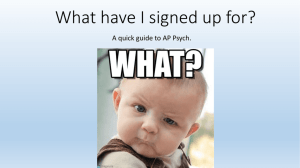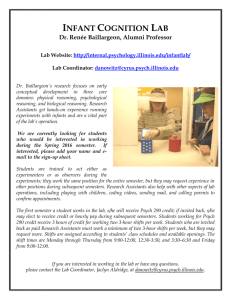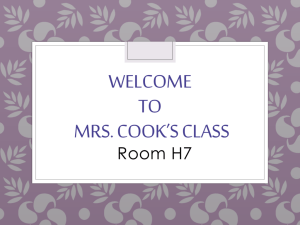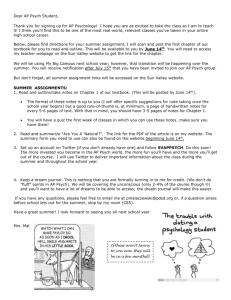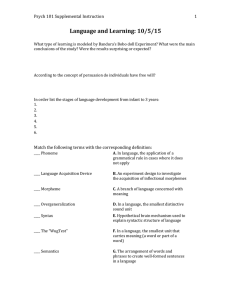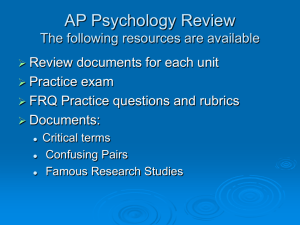Review Sheet - Semester Test - Spring 2011
advertisement
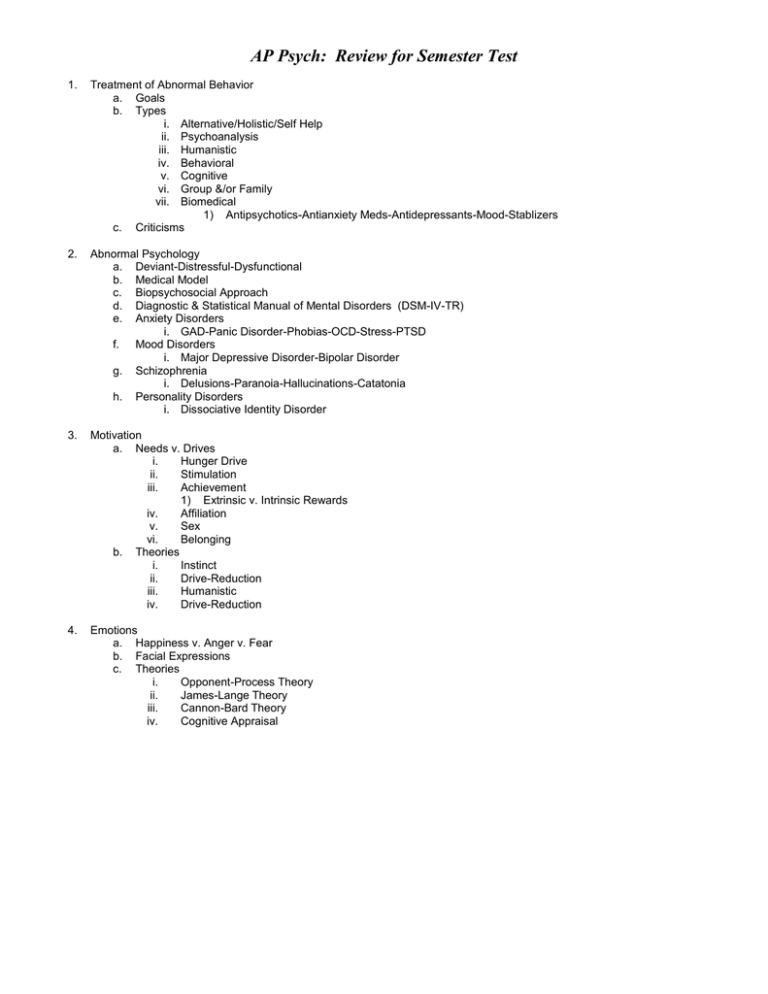
AP Psych: Review for Semester Test 1. Treatment of Abnormal Behavior a. Goals b. Types i. Alternative/Holistic/Self Help ii. Psychoanalysis iii. Humanistic iv. Behavioral v. Cognitive vi. Group &/or Family vii. Biomedical 1) Antipsychotics-Antianxiety Meds-Antidepressants-Mood-Stablizers c. Criticisms 2. Abnormal Psychology a. Deviant-Distressful-Dysfunctional b. Medical Model c. Biopsychosocial Approach d. Diagnostic & Statistical Manual of Mental Disorders (DSM-IV-TR) e. Anxiety Disorders i. GAD-Panic Disorder-Phobias-OCD-Stress-PTSD f. Mood Disorders i. Major Depressive Disorder-Bipolar Disorder g. Schizophrenia i. Delusions-Paranoia-Hallucinations-Catatonia h. Personality Disorders i. Dissociative Identity Disorder 3. Motivation a. Needs v. Drives i. Hunger Drive ii. Stimulation iii. Achievement 1) Extrinsic v. Intrinsic Rewards iv. Affiliation v. Sex vi. Belonging b. Theories i. Instinct ii. Drive-Reduction iii. Humanistic iv. Drive-Reduction 4. Emotions a. Happiness v. Anger v. Fear b. Facial Expressions c. Theories i. Opponent-Process Theory ii. James-Lange Theory iii. Cannon-Bard Theory iv. Cognitive Appraisal AP Psych: Review for Semester Test 5. Social Psychology a. Attribution Theory i. Dispositional v. Situational Attribution ii. Fundamental Attribution Error b. Attitudes & Actions i. Food-in-the-Door Phenomenon ii. Cognitive Dissonance c. Conformity & Obedience i. Asch’s Conformity Experiment & Group Pressure ii. Milgram’s Obedience Experiment iii. The Hawthorne Effect d. Group Influence i. Social Facilitation ii. Social Loafing iii. Deindividuation iv. Group Polarization v. Groupthink e. Prejudice-Stereotypes-Discrimination f. Aggression g. Attraction h. Altruism 6. Personality a. Freud & Psychoanalysis i. Exploring the Unconscious: Id-Ego-Superego ii. Psychosexual Stages of Development iii. Defense Mechanisms iv. Neo-Freudians a. Maslow, Rogers & Humanistic Perspective i. Maslow’s Hierarchy of Needs ii. Rogers’ Person-Centeredness b. Trait Perspective i. Myers-Briggs Type Indicator (MBTI) 1) Extrovert v. Introvert (E v. I) 2) Sensing v. Intuition (S v. N) 3) Feeling v. Thinking (F v. T) 4) Judging v. Perceiving (J v. P) ii. Minnesota Multiphasic Personality Inventory (MMPI) iii. Big Five 1) Conscientiousness-Agreeableness-Neuroticism-OpennessExtraversion c. Social-Cognitive Perspective i. Personal Control 1) Internal v. External Locus of Control 2) Learned Helplessness v. Personal Control 3) Optimism v. Pessimism 7. Human Growth & Development a. Conception & Prenatal b. New Born & Infancy c. Childhood d. Adolescence e. Adulthood (early-middle-late) f. Theories i. Piaget’s Cognitive Development ii. Harlow’s Attachment Theory iii. Kohlberg’s Moral Development iv. Erikson’s Psychosocial Development v. Kubler-Ross’ Stages of Death & Dying AP Psych: Review for Semester Test 8. Intelligence a. Def: the ability to learn from experience, solving problems, and use knowledge to adapt to new situations b. General (g) v. Multiple Intelligence (Triarchic Theory) i. Primary Mental Abilities ii. Savants c. Testing i. Aptitude v. Achievement ii. Stanford-Binet & IQ 1. Normal Distribution: retardation-genius 2. Flynn Effect iii. WAIS & WISC iv. Validity v. Reliability 3. Bias & Stereotyping d. Nature v. Nurture i. Biology & Twin Studies ii. Education iii. Ethnicity & Gender 9. Cognition a. Memory i. Encoding 1. Visual-Acoustic-Semantic 2. Rehearsal 3. Chunking 4. Hierarchies ii. Storage 1. Sensory Memory a. Iconic v. Echoic 2. Short-term / Working b. 30 seconds c. Magic 7 Theory d. Central Executive 3. Long-term e. Serotonin & Long-term Potentiation f. Implicit v. Explicit g. Flashbulb iii. Retrieval 1. Cues-Context-Mood iv. Forgetting 1. Encoding-Decay-Interference-Motivation b. Thinking i. Prototypes-Algorithms-Heuristics-Insight ii. Problems 1) Confirmation Bias-Fixation-Overconfidence-Framing 10. Learning a. Classical Conditioning (Pavlov) i. US v. CS ii. UR v. CR iii. Acquisition iv. Extinction & Spontaneous Recovery v. Generalization v. Discrimination b. Operant Conditioning (Skinner) i. Shaping ii. Reinforcers 1. Schedules a. Continuous v. Partial b. Fixed v. Variable c. Ratio v. Interval 2. Positive v. Negative 3. Punishment c. Other i. Latent Learning ii. Intrinsic v. Extrinsic Motivation iii. Observational Learning & Modeling iv. Taste-aversion (Garcia effect) AP Psych: Review for Semester Test 11. States of Consciousness a. Facets & Levels of Consciousness (Freud) b. Sleep & Dreams i. Circadian & Homestatic ii. Cycles & Stages 1) 1-4; REM; Alpha-Beta-Theta-Delta iii. Latent v. Manifest Dreams (Freud) iv. Disorders: Insomnia, Sleep Apnea, Narcolepsy, Nightmares/Terrors, Parasomnia (sleep walking) c. Drugs i. Depressants-Hullucinogens-Stimulants ii. Tolerance-Dependence-Addiction-Withdrawal d. Other States of Consciousness i. Hypnosis-Near Death Experiences-Mediation 12. Sensation & Perception a. Perception i. Absolute Threshold ii. JND b. Big Two: Vision & Audition i. Parts of the Eye: Cornea, Iris, Pupil, Lens, Retina (Rods & Cones)-Optic Nerve 1) Problems: Nearsighted, Farsighted, Blindness i. Parts of the Ear: Pinnea-Auditory Canal-Tympanic Membrane-Ossticles-Choclea-Auditory Nerve 1) Problems: Conductive & Sensorineural Deafness c. Other Three: Olfaction, Gustation, Tactition i. Gate Control Theory d. Perception i. Gestalt Psychologists ii. Cocktail Party Effect iii. Monocular & Binocular Cues iv. Depth Perception v. ESP-Precognition-Telepathy-Clairvoyance 13. Biology of Psych a. Nature v. Nurture b. Neuron i. Parts & Functions: Dendrite, Cell Body, Axon, Action Potential, Myelin, Terminals, Synapse, Neurotransmitters c. Brain i. Hemispheres: Right v. Left ii. Lobes of the Brain & Functions: Frontal, Parietal, Temporal, & Occipital 1) Broca’s & Wernicke’s Areas iii. Limbic System: emotional behavior 1) Hypothalamus (aggression, appetite, body temp) 2) Cerebellum (coordination & movement) 3) Medulla (heart, breathing & digestion) iv. Methods to Study 1) Accidents & Lesions – lobotomy 2) EEG (exterior) & EBS (interior) 3) Scans (SD, HD, 3D): CAT, MRI, PET d. Nervous System i. Central v. Peripheral 1) Auto v. Somatic 2) Sympathetic v. Para 3) Efferent v. Afferent e. Endocrine System i. Glands: Pituitary, Thyroid, Adrenal, Testes, Ovaries ii. Hormones: Oxytocin, Thyroxin, Adrenialine & Noradrenaline, Testosterone, Estrogen & Progestorene AP Psych: Review for Semester Test 14. Research Methods/Ethics/Stats a. Types of Studies i. Qualitative v. Quantitative ii. Descriptive v. Inferential (Goal - Observe, Describe, Explain, & Predict Behavior) 1) Survey 2) Naturalistic 3) Case 4) Correlation iii. Experiments (Goal - Control Behavior) b. Ethics: gains of science should not outweigh the harm done to subjects c. Stats i. Population-Sample (Randomization) ii. Mean-Median-Mode iii. Standard Deviation 15. Theories & Famous Psychologists a. Old School i. Greeks (Plato, Socrates, Aristotle) ii. Enlightened (Descartes, Bacon, Locke) iii. Structuralism (Wundt) iv. Functionalism (James-textbook) v. Psychoanalysis (Freud) vi. Behaviorism (Watson and Little Albert & Skinner and the “Skinner Box”) vii. Humanistic (Maslow) b. New School i. Neuroscience/Cognitive/Biological ii. Behaviorism/Learning iii. Sociocultural c. Approaches to Psych i. Basic v. Applied 1) Experimental ii. Psychiatry iii. Clinical v. Counseling iv. School v. Educational v. Developmental v. Personality v. Social vi. Environmental v. Consumer v. Industrial/Organizational

